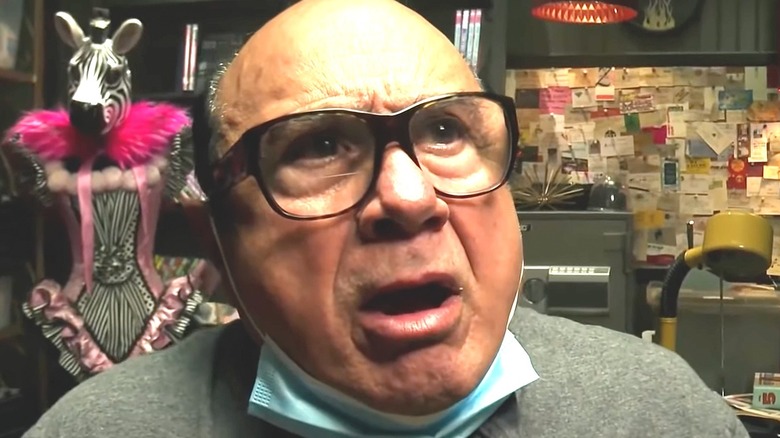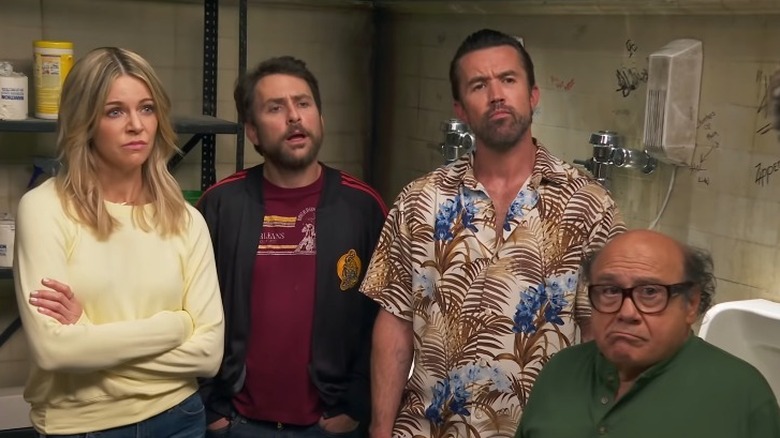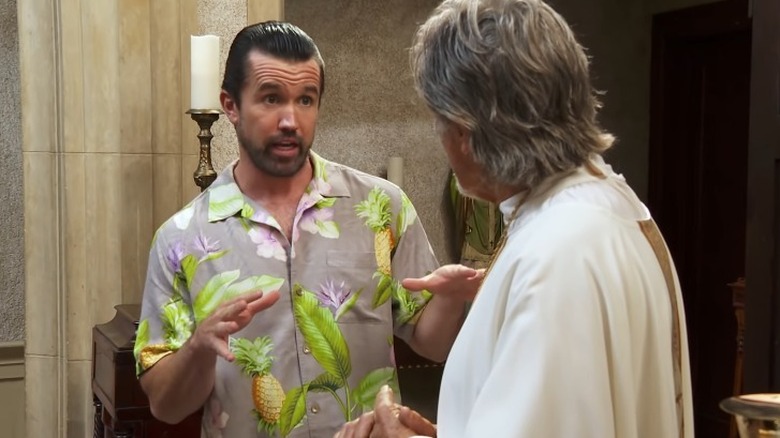How A Nightmare Inspired The Creation Of It's Always Sunny In Philadelphia
While the characters in "Friends" might stick to their show's theme song about being there for each other, the same can't be said for the infamous "Gang" in the FX sitcom "It's Always Sunny in Philadelphia." Created by Rob McElhenney and Glenn Howerton, who also star along with Charlie Day, Kaitlin Olson, and Danny DeVito, the show follows a narcissistic and sociopathic group of friends on some of their most brazen misadventures in Philadelphia. With "It's Always Sunny," envelopes aren't pushed; they're shredded. Taboos seem less like a restriction and more of a barricade to mischievously knock down. Really, the Gang is the worst bunch of people anyone could be unfortunate enough to meet.
Yet, there's something magnetic about watching them commit to their psychopathic ways, especially when their results often backfire in their faces. It's what's helped the series run for a record-breaking number of seasons. "It's Always Sunny in Philadelphia" has produced some of the most surprising standout moments on television, from the beloved "The Nightman Cometh" in Season 4 to the masterpiece interpretative dance scene in the Season 13 finale. However, the series has never drifted away from its general depraved theme, which actually has a nightmarish origin from McElhenney.
Rob McElhenney's nightmare set the tone for the series
They often say that a good night's rest can set up a successful tomorrow. But when it comes to "It's Always Sunny In Philadelphia," the key to success is actually a lousy night of unrest. According to an interview with Entertainment Weekly, Rob McElhenney had a nightmare about a man with cancer, whose friend didn't have an ounce of empathy. He immediately wrote a script based on the dream and shared it with Glenn Howerton and Charlie Day. McElhenney described the nightmare to EW: "It was just an idea of a guy going over to another guy's house to ask him for sugar, and the other guy telling him that he has cancer. And instead of the friend being compassionate, he just wants to get the sugar and get out the door."
As also noted by Entertainment Weekly, McElhenney, Howerton, and Day filmed a home movie episode for less than $200, which FX picked up. However, the network asked for some notable changes with the show. For one, while the pilot was set in Hollywood, the series would move to South Philadelphia. And Olson got added to the cast. However, what has stayed constant is the idea of making comedy based on terrible people and horrific situations. As McElhenney, Howerton, and Day revealed on the "The Always Sunny Podcast," scenes from the original home movie got reshot and reused for the Season 1 episode, "Charlie Has Cancer."
There have been a few regrettable moments with the show
On the "The Always Sunny Podcast," Howerton and McElhenney noted that in writing the original home video pilot, the goal was to tackle the challenge of making something that's terrible or dark into something funny. Take a glance at the rap sheet on some of the worst things "The Always Sunny In Philadelphia" Gang has ever done, and you'll find some hefty crimes of underage drinking and even trapping people in a burning building. And that's just for starters. While for the most part, the cast's horrid actions have equaled laughs, there are times when the comedy felt like it was punching down. Often, the show tries to remedy its cringeworthy and hurtful scenes by either stubbornly sticking to its satirical point or organically addressing and fixing these faux pas in its absurdist way.
The latter can be tied back to McElhenney, who realized that "It's Always Sunny" has long suffered from a lack of diversity, which has resulted in some blatantly ignorant scenes or even entire episodes. In an interview with Esquire, McElhenney said that the hurtful transphobic slurs used in earlier seasons and the initial handling of his own character's sexuality were results of the absence of representation in the main cast. He noted that "We can't go back and re-edit those episodes, but what we can do is make sure that as we're moving forward, we're making those adjustments and doing our due diligence." Whether the show succeeds in recognizing and facing its regrettable moments in retrospect is debatable. But it is noteworthy that there are some aspects of "It's Always Sunny" that even McElhenney regrets.


